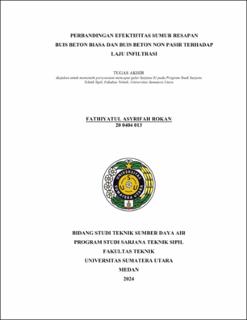Perbandingan Efektifitas Sumur Resapan Buis Beton Biasa dan Buis Beton Non Pasir terhadap Laju Infiltrasi
Comparison of The Effectiveness of Ordinary Concrete Infiltration Wells and Non-Sand Concrete on Infiltration Rates

Date
2024Author
Rokan, Fathiyatul Asyrifah
Advisor(s)
Indrawan, Ivan
Sembiring, Robi Arianta
Metadata
Show full item recordAbstract
Based on data from the Central Statistics Agency for the city of Medan, the
population in the city of Medan in 2021 was 2,460,858 people and experienced an
increase of 1,349% in 2022. The increase in population in the city of Medan
indirectly has an impact on increasing the need for land use for shelter and
reducing rainwater catchment areas, if this condition continues it can cause
inundation or even flooding. Therefore, there is a need for an environmentally
sound development concept that seeks excessive water management by
containing, absorbing, flowing and maintaining so that it does not cause
inundation and danger to the environment. This concept is in line with how
infiltration wells work. From the description of this problem, an infiltration well is
needed that can speed up the infiltration rate, according to SNI 8456:2017
concerning Rainwater Infiltration Wells and Trenches, there are 4 types of
infiltration wells. In this research, a comparison was made of 2 types of
infiltration wells, ordinary concrete infiltration wells and non-sand concrete
infiltration wells to the infiltration rate. Using the Horton method infiltration rate
calculation, it was found that the infiltration rate for ordinary concrete infiltration
wells was 22,000 cm/hour, while the infiltration rate for non-sand concrete
infiltration wells was 53,000 cm/hour. From these results, it can be concluded that
non-sand concrete infiltration wells are more effective in accelerating the
infiltration.
Collections
- Undergraduate Theses [1512]
